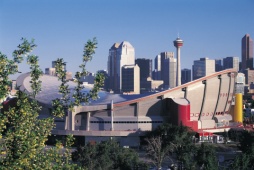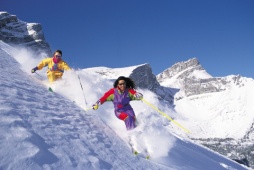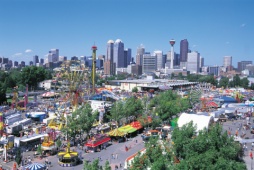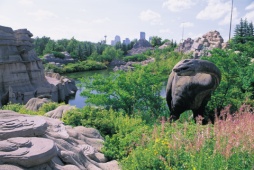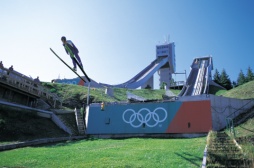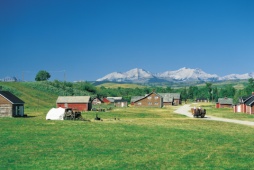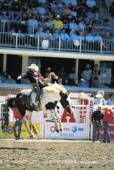
|
|||||||||||||||||||||||||||||

|
|||||||||||||||||||||||||||||
Calgary, Alberta, Canada
|

|
||||||||||||||||||||||||||||
Calgary's visitor attractions, events and festivals offer something for everybody. Tour the 1988 Winter Olympic site, climb the Calgary Tower and enjoy fascinating views of the city and the mountains, visit the zoo with its outstanding botanical garden and prehistoric park or explore Spruce Meadows, an international-calibre equestrian facility, during one of their major events. Discover the history of Canada's west and Calgary's early days at Heritage Park, the Glenbow Museum or Fort Calgary. Enjoy Calgary's rich cultural life with its theatre, art galleries, symphony, ballet and opera. Gourmets will find every cuisine imaginable - from the exotic dishes of the Far East to the latest food experiences served up in beautifully restored restaurants. Spend a day or two at one of Calgary's many festivals or join the fans at a live hockey, baseball or football game. Calgary's symbol of hospitality is for more than 50 years the White Cowboy Hat. Over the years, thousands of visitors, including celebrities such as Bill Cosby, have received white hats during a distinctly Calgarian swearing-in ceremony. After a reading a declaration and trying out a 'yahoo", the distinction of being an honorary Calgarian is officially bestowed upon the visitor. Hit the trail and explore cowboy country. There is plenty of the wild, wild west to experience! Whether you saddle up for an hour, a day or a week - there are trips and horses for everyone from the tenderfoot to the more experienced rider. Crisp winter air and sun-filled days attract outdoor enthusiasts of all kinds. Cross-country skiers stride across snow-covered park trails or along city pathways. Downhill skiers and snowboarders head to Canada Olympic Park, "Calgary's Family Ski Area". Skaters have the choice of the lagoon at Bowness Park or the skating rink at the Olympic Plaza in downtown Calgary.
Calgary is the gateway to a world of outdoor adventure. The area is home to some of the most beautiful official and unofficial parklands in the world including Kananaskis Country, Banff, Jasper and Yoho parks. Outdoor activities include hiking, kayaking, dog sledding, fishing, rock climbing, cycling, ballooning, rafting, camping and many others. Calgary in figures Calgary is the second largest municipality in Canada with a total area of 721 square kilometres (278.54 sq mi) Calgary has a population of 951,395 (Census 2002). Calgary has an elevation of 1,048 metres (3,440 feet) above sea level. Calgary is the largest city of Alberta. Calgary is the second largest head-office city in Canada. Arrival Calgary's International Airport is just 20 minutes from the city centre and is located at the junction of Alberta's major highways: Trans Canada #1 and Highway #2 to Edmonton. Many airlines offer regular non-stop flights to Calgary from major North American and European cities and the Asia Pacific. Airlines include Air Canada, British Airways, Lufthansa, United Airlines and others. For more information visit the Calgary International Airport website. The individual traveler will arrive by car. Highway 2 runs north to Edmonton and south to the U.S. border; Highway 1 runs east to Saskatchewan and west to Banff and the province of British Columbia.
Public Transportation Calgary Transit operates a full bus schedule within Calgary. For route and schedule details call Calgary Transit Info at (403) 262-1000. For more information visit the Calgary Transit website. City Cycling Paths Tour Calgary on one of the city's extensive bike paths. Calgary's 300 kilometres (180 mi) of well-groomed paths link all areas of the city. Bike Trail maps are available at the City of Calgary, cycle shops and other retailers. Bike rentals are available. Orientation within the city If you are looking for certain addresses within the city of Calgary, you should be aware, that there is a system in place. It will take you a while to figure out, how it works, but if you don't you will never make it. Once you are familiar with it, it will be easy. The entire city is divided into four geographical segments, which are always indicated in addresses and on street signs. Those are N.W. (north-west), N.E. (north-east), S.W. (south-west), and S.E. (south-east). North and south are divided by the Bow River and Memorial Drive; the northern part of the city and downtown is divided by Centre St to east and west.; the southern part is divided by Macleod Trail. Streets within the city generally run north and south, avenues run east and west. Climate Calgary is known for its sunny skies and a moderate four-season climate. Alberta receives more hours of sunshine yearly than any other province in Canada. Average temperatures are: Summer (June to Aug.): 20ºC (68 ºF) Fall (Sep. to Nov.): 11 ºC (52 ºF) Winter (Dec. to Feb.): -11 ºC (12 ºF) Spring (March to May): 9 ºC (48 ºF) Calgary and area experiences a winter phenomena called Chinook - a warm, dry wind that develops over the Rockies and can raise temperatures more than 20 degrees in a few hours. Parks and protected areas Calgary is blessed with some of the finest natural areas within a Canadian municipality. Fish Creek Provincial Park  Located at the south end of Calgary and extending from the western edge of the city to the Bow River, Fish Creek Provincial Park is the largest urban park in Canada. The park protects more than 10 kilometres (six miles) of river valley providing habitat for animals and birds. Calgarians can walk and cycle along beautiful trails or learn about Calgary's ranching history at the Park's Visitor Service Centre. For more information call (403) 297-5293
Things to do Calgary offers an outstanding variety of museums and historic sites. The area's history from pre-historic times to the present day is well documented. Calgary Chinese Cultural Centre  The Chinese Cultural Centre is located at 197-1st St. S.W. and consists out of a Chinese restaurant, a cultural museum housing priceless artefacts and ceramic arts, as well as an arts and crafts store. The six-storey Great Cultural Hall is modeled after the Temple of Heaven in Beijing and has been finished after more than 100,000 man-hours of Chinese artisans were put in. For more information call (403) 262-5071. Calgary Tower  Calgary Tower, located in the heart of downtown Calgary, acts as a landmark and symbol of the city and is a must see. The tower's lobby houses a display of the Towers of the World. Climb the Observation Terrace of the 191-metre tower and enjoy a breathtaking panoramic view of the city and the spectacular Canadian Rockies. A revolving restaurant offers breakfast, lunch or dinner while enjoying the view. For more information call (403) 266-7171 Calgary Zoo, Botanical Garden and Prehistoric Park  Calgary Zoo is located east of downtown on St George's Island and marks one of Canada's largest and best zoological institution. The Calgary Zoo, Botanical Garden and Prehistoric Park houses more than 1,400 animals, thousands of plant species and a unique Prehistoric Park teeming with life-size dinosaur models. Underwater viewing areas give an insight in the life of polar bears, seals and other animals as they behave beneath the water. For more information call (403) 232-9300
Heritage Park Historical Village  The Heritage Park is located at 1900 Heritage Drive at the junction of 14th St S.W., south-west of downtown. The 26 hectares park is Western Canada's largest living historical village and recreates life in a town of the Canadian west prior to 1914. See a Hudson's Bay Company fort, an 1896 church, a working grain mill, a schoolhouse, a teepee and others at this well-laid-out frontier village. Cruise aboard of the S.S. Motie paddlewheeler or ride an old steam locomotive. For more information call (403) 259-1900 Spruce Meadows  Located south of Calgary, Spruce Meadows is an internationally renowned equestrian facility. Three major show jumping championships, such as The National, The North American and the Masters, take place at Spruce Meadows. For more information call (403) 293-4884 Calgary Police Service Interpretive Centre  Calgary Police Service Interpretive Centre is located at 133-6th Avenue S.E. and is the only centre of its kind in Canada. Play detective while using interactive computer/video exhibits to solve crimes and learn about forensic science using true-to-life Calgary cases. For more information call (403) 268-4565 Fort Calgary  Fort Calgary is located at 750-9th Avenue S.E., east of downtown. The 40 acres riverside park, where Calgary's original settlement began, displays the stories of the site, the settlement and the people with displays and a video show on the Northwest Mounted Police. Only a few foundations are the remains of the old fort. The Hunt House, most probably one of the oldest buildings in Calgary, was built by the Hudson's Bay Company in 1876. Deane House, next door, was built in 1906 by Captain Richard Deane of the NWMP and houses nowadays a restaurant. For more information call (403) 290-1875 or (403) 269-7747 (Deane House) Museum of the Regiments  The Museum of the Regiments is located at 4520 Crowchild Tr. S.W. and is western Canada's largest military museum. The museum houses the regimental collections of CFB Calgary and Calgary's four regiments - Lord Strathcona Horse (Royal Canadians), the King's Own Calgary Regiment, Princess Patricia's Canadian Light Infantry, and the Calgary Highlanders. For more information call (403) 974-2850
 On April 29, 1903 at 4:10 a.m., the side of Turtle Mountain above the Town of Frank, gave way, burying part of the town in more than 90 million tons of rubble in only 90 seconds. Of the 600 residents of the town approximately 70 were killed. The Frank Slide Interpretive Centre documents this extraordinary event. The town of Frank is located in the Crowsnest Pass area in the south-western corner of the province, about three hours from Calgary. For more information call (403) 562-7388 Head-Smashed-In Buffalo Jump  Head-Smashed-In Buffalo Jump is located approx. 18 km north-west of Fort Macleod, on Spring Point Road off Hwy 2. From Calgary it is a 90 minutes drive south. As one of the largest and best preserved buffalo jump sites in North America, it is the most significant attraction in southern Alberta. It is a UN World Heritage Site and offers an interpretive centre and jump site, that documents the Blackfoot's culture of buffalo hunting. For thousands of years until the arrival of the Europeans, they used to run bison through drive lanes over the edge of the cliff. The site is named according to a legend, that tells the story of a young man who wanted to see a killing from beneath the cliff but became trapped and was crushed by the falling bison. For more information call (403) 553-2731
 Don't miss the Eau Claire Market, adjacent to the Bow River and Prince's Island Park! You will find a wide range of restaurants along with unique specialty shops. Fourth Street and Uptown 17th Avenue Scenic neighbourhoods with many fine restaurants, bars, nightclubs and upscale shopping awaits you at Fourth Street and Uptown 17th Avenue. Chinatown Calgary's large and vibrant Chinatown, located adjacent to the city core, offers authentic Chinese cuisine. Western Flavour Don't miss the opportunity to taste world-famous Alberta beef! Try prime rib or steak at one of the western dance hot spots or at a steak house, while you are in the heart of cattle country. During the Calgary Stampede, try a breakfast of syrup-covered flapjacks and crispy-fried bacon served daily from the back of chuckwagons located in shopping malls or street corners. Entertainment Experience everything from free street entertainment to live professional sports to world premiers of plays, music and dance in Calgary and area. Performing Arts Calgary offers several live theatre venues. There are professional theatres such as the Theatre Calgary and Alberta Theatre Projects, as well as other locations offering satires, improvisational comedies, or murder mystery evenings. Enjoy an evening with the Calgary Philharmonic Orchestra or visit one of the many non-professional groups. Nightlife Cowboy country is known for its many popular western clubs. Nevertheless there is a myriad of jazz, blues, classic rock, or pop performances to meet any taste. Calgary's friendly pubs offer local beer some even brew their own stuff. Festivals and Events The city of Calgary has festivals or special events happening throughout the year. Some are listed below:
Every evening, nine heart-stopping world-championship chuckwagon races make an all-out dash to the finish during the Stampede's Rangeland Derby. In 1998, more than 1.25 million people attended the 10-day event which had an economic impact of more than $116.9 million for the city of Calgary. For more information call (403) 261-0101 or toll free at 1-800-661-1260 History Alberta's history as a Canadian province belongs primarily to the late 19th and 20th centuries. Before that time, Alberta was home to its native people whose presence in Alberta has been traced back to at least 11,000 years ago. The Canadian west remained largely uninhabited by white men, except for a few trading posts, until the late 19th century. The Hudson's Bay Company, granted a charter of extraordinary privileges to about one-third of North America in 1670, sent its representatives into the wilds of what is now Alberta to set up trading posts to trade with natives for furs. Anthony Henday, sent by the Hudson's Bay Company (HBC) to present-day Alberta in 1745 to persuade the natives to come to HBC forts to trade, was the first white man to visit the area. David Thompson, also of the Hudson's Bay Company, visited the area near Calgary in 1787 and is thought to be the first European to see the region. In addition to the general lack of order in the region, the natives primary source of food, the buffalo, was rapidly disappearing. Recognizing that the west was not secured from takeover south of the border and that neither a transcontinental railways nor immigration would take place in an area so beset by problems, Sir John A. MacDonald, Canada's first prime minister, created the North West Mounted Police (NWMP) in 1873. After the western territories became part of Canada in 1870, steps were taken to negotiate peace treaties with different tribes in Alberta. Calgary's history as a city began in 1875 when a detachment of North West Mounted Police arrived. The NWMP established Fort Calgary at the confluence of the Bow and Elbow Rivers in an area, at that time, had few permanent inhabitants. Calgary was named by NWMP Colonel James Macleod after Calgary Bay on the Isle of Mull, Scottland. By 1881, Calgary consisted of a Hudson's Bay Store, an I.G. Baker Company Store, the NWMP barracks and commanding officer's house and a population of 75 people. It wasn't until the arrival of the Canadian Pacific Railway in 1883 that the population of Calgary began to climb. By 1885, the population had jumped to approx. 1,000 to 2,000 by 1889; and nearly 4,000 by 1891. On November 7, 1884, Calgary was officially incorporated as a town and less than a decade later, on January 1, 1894, the town became a city. In 1905, Alberta and Saskatchewan joined the Canadian confederation as provinces. Oil industry began in Turner Valley oilfields, 35 kilometres (22 mi) south-west of the city, in 1914 and with the Leduc oil field discovery of 1947. The oil field discovery was to change the future of the area forever. Because of the rapid development of energy industries, Calgary's population more than doubled between 1959 and 1979, increasing from 218,418 to 530,816. In 1912, four local wealthy ranchers financed the Calgary Stampede as a one-time event. The Stampede was revived in 1919, but wasn't until 1923 that the Stampede became an annual event. In 1982, Calgary became Canada's second-largest city by area. Calgarians welcomed the world during the Olympic Winter Games in February 1988. Alberta's native tribes, or "First Nations" occupy eight reserves in the province. Four of these reserves are located close to Calgary - the Siksika, Peigan, Tsuu T'ina and Stoney. Maintaining their culture is an important part of First Nations life. Visitors are always welcome at powwows and rodeos where competitors come from all over North America to participate in dancing competitions and rodeo events. |
|||||||||||||||||||||||||||||
More Travel Tips
|
|||||||||||||||||||||||||||||
